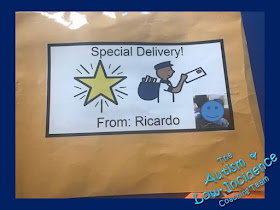There are many types of breaks that students may benefit
from, each with their own distinct purpose. It is important that staff works to establish clear boundaries between each type of break to increase student success and ensure you get the most out of this support. More information about the three
main types of breaks: Reinforcement, Sensory, and “In the Moment” breaks can be
found in today's Around Town Round Up.
Reinforcement Breaks
Other Names: reward, free time, earned
When to use: Reinforcement breaks are contingent upon
behavior and/or work completion. They are used to motivate students. Visual
supports assist students in understanding expectations for earning breaks.
Depending on student needs, reinforcement breaks may occur after each task,
class period, daily, or weekly.
What they look like: During a reinforcement break, the student
is allowed to engage in a highly preferred activity or interest for a
predetermined amount of time.
Examples:
- Student
completes three tasks in a structured work system, and then earns Legos for 5
minutes.
- Student
completes math assignment, and then earns iPad game time for remainder of the
class period.
- Student
earns 10 Dojo points, and then earns a snack break at the end of the day.
- Student
turns in homework all week, and then earns free drawing time during study hall.
 |
Kelli Tritschler
Mound Elementary, Miamisburg |
 |
Leslie Mann
Demmitt Elementary, Vandalia |
 |
Jennifer McGowan
Smith Middle School, Vandalia |
 |
Emily Ottmar
Stevenson Elementary, Mad River |
Sensory Breaks
Other Names: brain breaks, calming breaks, movement breaks
When to use: Sensory breaks should be proactively scheduled
and should not be contingent upon behavior or work completion. Providing
embedded sensory breaks helps to promote and maintain self-regulation which
helps the student focus and learn. Generally speaking, all students may benefit
from one sensory break in the morning and one in the afternoon. Frequency may
be increased based on individual student needs. Recommendations may be made by
the student’s occupational therapist to determine frequency.
What they look like: Sensory breaks can be beneficial as an
individual support and/or a class-wide support. They may occur within the
classroom or in another designated location. Participation in sensory breaks
should result in students feeling/appearing calmer and more regulated.
Recommendations may be made by the student’s occupational therapist to
determine appropriate activities and supports.
Examples:
- Student
goes to a designated sensory room for 10 minutes to engage in a structured
calming routine (i.e. body sock, rocking chair, wall pushes).
- Student
transitions out of the classroom to participate in a designated purposeful walk
(i.e. push heavy cart to the cafeteria).
- Student
manipulates fidgets in a beanbag chair in the back corner of the classroom for
5 minutes.
- Class
participates in calming GoNoodle activities (i.e. Stretch and Breathing
videos).
 |
Amy Beanblossom
Arcanum Elementary, Arcanum |
 |
Leslie Mann
Demmitt Elementary, Vandalia |
 |
Keelin DiMuccio
Fairbrook Elementary, Beavercreek |
“In the Moment” Breaks
Other Names: requested breaks, break card breaks, as needed
breaks
When to use: Sometimes a student needs a brief break from
classroom demands in the moment to regain focus and calm down. These breaks may
be requested by the student or initiated by staff. These breaks can be used as
a replacement for interfering escape behaviors during work times.
What they look like: “In the moment” breaks work best when
they have minimal transitions and have a definite ending point. They should be
less motivating than a reinforcement break. They may vary in length depending
upon the amount of time needed for the student to de-escalate. After an “in the
moment” break, the student returns to the assigned task.
Examples:
- Student
requests break using break card and staff removes task from work space for 1
minute.
- Staff
notices signs of escalation and provides student with dots and squeezies in the
moment.
- Student
asks for break and walks to drinking fountain for a drink and returns to work.
- Staff notices that a student is starting to get upset so they ask them to run an errand.
- Student asks to work in a designated home base location when starting to feel overwhelmed while working.
 |
Rylie Jarrett
Stevenson Elementary, Mad River |
 |
Leslie Mann
Demmitt Elementary, Vandalia |
 |
Emily Ottmar
Stevenson Elementary, Mad River |
 |
Christine Scarborough
Tecumseh Elementary, Xenia |
 |
Rachel Hatton
Normandy Elementary, Centerville |
 |
Beth Young
Snyder Park Elementary, Springfield |






















































